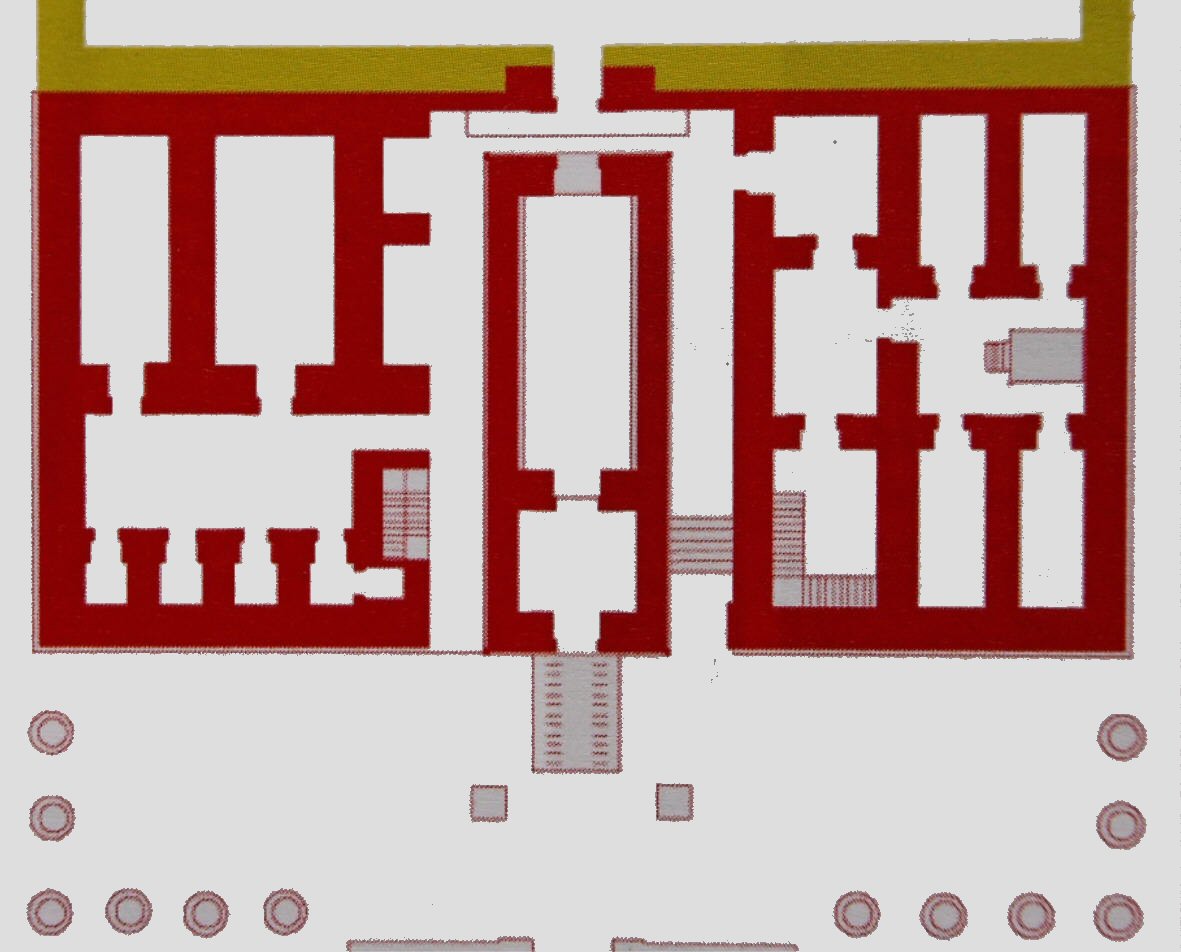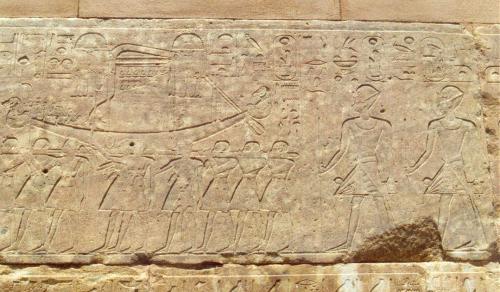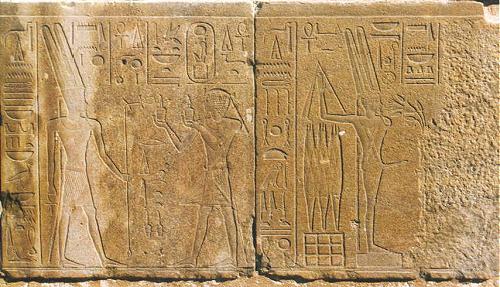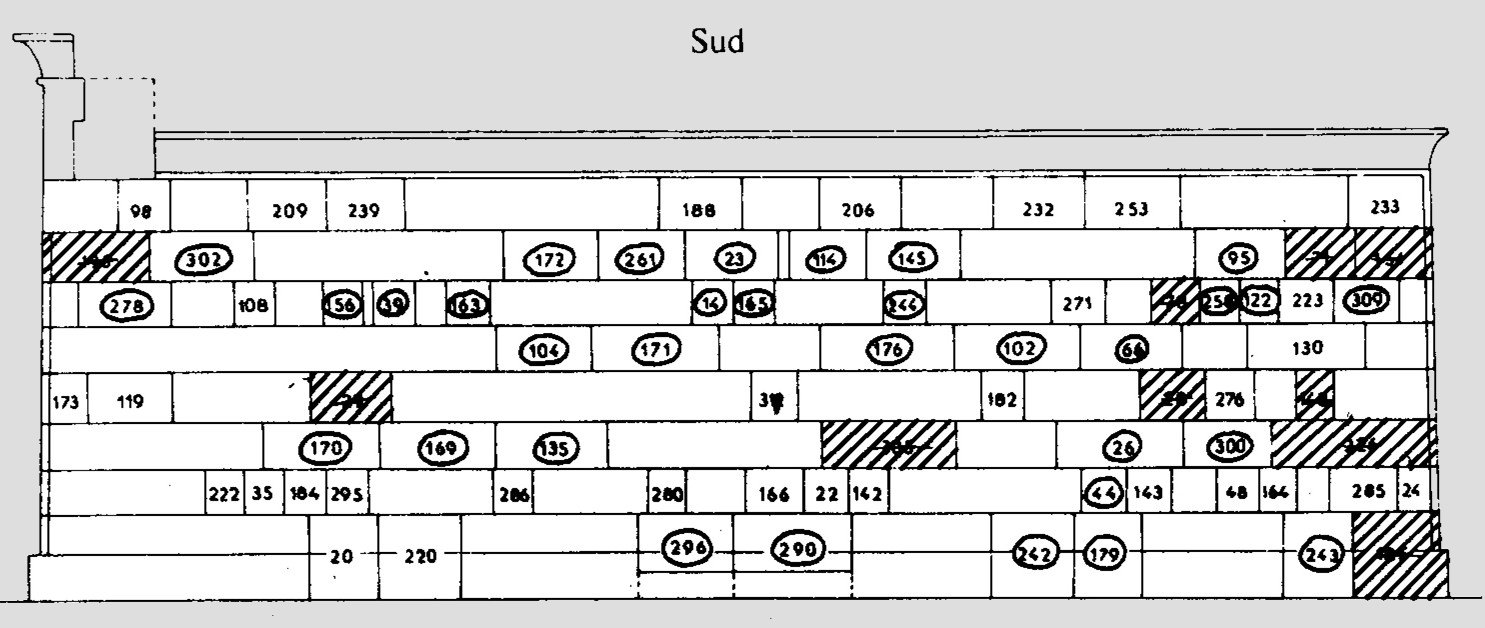|
Red Chapel of Hatshepsut |
last update:
03.01.2012
|
| Today, the tourist district the temple at Karnak includes the
"Open Air Museum" (OAM) that, however, it is separated from the
other parts of area and the admission costs extra. To find the OAM one has to enter
the great court yard with the column of Taharqa between 1. and 2. Pylon, leave
the courtyard to the left and follow the way towards the public lavatories.
Among others several barqueshrines, e.g. the "White Chapel" of Senwosret
I, the "Alabaster Shrine of the Amenhotep / Thutmosis I, the "Kiosk" of Thutmosis
IV., and also the so-called "Red Chapel (Chapel rouge)" of Hatshepsut
have been re-erected and can be visited in the OAM.
|

| Red Chapel (North side) - "The favorite place of Amun" |
| Some years before her death Hatshepsut started the building of this
barqueshrine which was built by blocks of quartzite and diorite. Because none of
the stone blocks was found in situ, the original location has been discussed
controversially. However, with great certainty the Red Chapel had been
erected in the central area of the Amun district at Karnak. The archaeological
findings of French excavators gave evidence that the Red Chapel had been
built in the middle of the building complex, which Hatshepsut had erected in
front of the Amun temple from the Middle Kingdom.
|
| Initially, the Red Chapel was positioned into this
building complex in such a way that it projected from to the west-side of the complex. In the
meantime French archaeologists reconstruct the position of the chapel in the
middle of the building complex in such a way that it precisely fits into the front
of the complex (Burgos, Larché, 2006).
|

| Current assumption about the original location of the Red
Chapel (detail taken from Burgos, Larché, 2008, plan page 254). Above in yellow-brown
the wall of the courtyard from the MK, in red the building complex of the
Hatshepsut with the Red Chapel inside. |
| When Red Chapel was re-erected at the "Open Air
Museum" the
chapel was turned by about 90° in comparison with its
original location i.e. the main entrance, which was originally aligned to the west - to the Nile
- today points southward to Luxor temple. However, all directions given herein always refer to
the original adjustment of the chapel.
|
| After the death of Hatshepsut the decoration of the chapel was continued
by Thutmosis III and probably changed with the intention to usurp it for
himself. Finally however the barqueshrine was dismantled by Thutmosis III, whereby
he re-used some blocks in the holy shrine of Amuns that he erected in the heart of Karnak
temple. The remaining blocks were stored elsewhere for a further use. In modern time
some blocks were found in the foundations of the temple of Ptah (in the
eastern part of Ipet Isut) and in the proximity of the 9. Pylon. The majority of the
blocks, however, were used by Amenhotep III (3 generations after the
chapel had been taken down) as filling for the 3. Pylon at Ipet Isut - within they
got perfectly conserved.
|
|
Some hundred blocks were discovered between 1898 and 1999, examined, and stored
in the Open Air Museum on concrete benches for many years. Its reconstruction
started in 1997 nearly one century after its initial discovery.
The egyptological investigation of the blocks by the "Centre
franco-égyptien d'étude des temples de Karnak (= CFEETK)" under the direction of Nicolas Grimal and Francois Larché
(see also Larché, F.," The Reconstruction of the So-Called "Red Chapel"
of Hatshepsut & Thutmosis III in the Open Air Museum at Karnak",
kmt, Vol. 10, No. 4, 1999-2000) resulted in a hypothetical reconstruction of the Red Chapel. |
|
But before the final rebuilding the architectural details of each block were
studied. The construction was led by the CNRS stonecutter Franck Burgos and
architect François Larché and ended in 2001 and was extensively published in
2006. Some pages in the www address the
reconstruction of the Red Chapel, e.g.:
Red
Chapel of Hatshepsut reconstructed
Chantier au
temple de Karnak
|
| In accordance with its position the Red Chapel is a
barqueshrine dedicated to Amun or to its ithyphallic manifestation of Amun.
Beside several portrayals in the relief also the decoration with lettuce friezes
points to Amun. Lettuce (Lactuca sativa) was the holy plant of Min, the god of
fertility, probably because it was assumed to have an aphrodisiac effect. During
the processions of Min a lettuce patch was carried along.
|
| Mostly, the blocks show Hatshepsut alone or together with Thutmosis
III
during different ritual actions (e.g. during the Opet festival, during the
adoration of Amun or Amun , during the cult run on the occasion of the
"heb-sed" celebration, etc.).
|
 |
| Hatshepsut - and behind her her coregent Thutmosis III - follow the
barque of Amun during the Opet festival. The cartouche of Maat-ka-Ra is
presented twice in the upper register (above the head of Hatshepsut and on the right top
above the last one of the priests carrying the bark), the cartouche of Thutmosis
III is shown left above his head. I n this scene both carry the Khepresch-
or Blue Crown.
|
| Some blocks show tracks of destruction,
e.g. on the following block the figure and the cartouche of Hatshepsut were
erased in the right register. However, the attempts were executed rather incompletely, as
shown in the left register.
|
 |
| The block above shows Hatshepsut offering in front
of Amun (left register) and his ithyphallic manifestation (on the right; the strange plants behind Amun probably represent
are lettuce, the holy plant of the god of fertility, Min). In the right register figure and cartouche of
Hatshepsut were erased.
|
These destructions which are also to be seen at other monuments of
Hatshepsut are often interpreted as an example of the "Damnatio memoriae"
of Thutmosis III.
Concerning the Red Chapel Meyer (Meyer, Chr., 1989) interprets the destruction
as an attempt Thutmosis III to usurp the chapel for himself. In her opinion the sporadic
deletions indicate that the attempt to decorate the blocks with new
relief failed either because the required large number of stone-cutters
was not available or type and quality of the stone material stopped the
work. The extraordinary quality of red quartzite was surely a reason for the attempt to re-use
the blocks but the hardness of the stone made it more difficult to erase
the old relief, smooth the surface and thereafter to cut a new relief.
|

| The distribution of the destroyed blocks on the southern
wall, which is now recognizable again after reconstructing the Red Chapel,
does not indicate a systematic reworking - in contrast, Dorman
interprets the more or less "random" distribution of destroyed
blocks as a hint that the decoration of these blocks was erased after
the Red Chapel had been taken down.
|
| The above figure of Lacau and Chevrier, 1979 (fig. taken from: Dorman,
1988), shows the southern wall of the Red Chapel. The blocks found are numbered, those, on which the number is encircled, show an intact representation of the
Hatshepsut, while dashed blocks had been changed.
|
| Unignorable blocks with undestroyed representations lie beside
such with destructions. In addition, the investigation of the preserved blocks
showed that 87 completely reached through the walls and had been decorated,
hence, on two sides showed (the inner and the outer side). 32 of them had been
changed intentionally, among them 11 blocks on which Hatshepsut had been
depicted o both sides - but only one sides had been destroyed. On farther
11 blocks her representations had been extinguished on both sides. |
| Furthermore, Loeben (personal communication, 2002) referred to the fact that the blocks had been provided
during the production with a "workshop signatures". These were attached
so that they were no longer accessible after the blocks had been finally
used up in the building. But also some of these "workshop signatures"
had been destroyed - this can have taken place only after the Red Chapel had been
dismantled.
|
Some blocks show Thutmosis III acting alone, e.g. the following block.
The picture was taken from below as one detects by the boundary to the next, left block,
i.e. this block is positioned something below the half height of the wall.
Thus, this block does not belong to the upper series of blocks, which were
- due to the current knowledge - added by Thutmosis III after the death of
Hatshepsut for the completion of the Red Chapel (see below).
|
The block shows Thutmosis III, wearing the Blue
or Khepresch-Crown, offering alone in front of Hatshepsut, who,
depicted as Osiris, stands in front of one of her way-stations between Karnak and Luxor temples (the edge of the way-stations is to be seen on the right behind her figure).
However,
this cannot be interpreted in that way that this block would have been decorated after the death of
Hatshepsut. It is just a representation within the framework of the usual "program". This also
testified by another block, which shows Hatshepsut offering in front of
her own Osiride figure - this scene also shows the Osiride figure of
Hatshepsut standing in front of one of the way-stations.
|
 |
| The right register shows Thutmosis III (his cartouche "Men-Cheper-Ra" is
directly above his head) offering in front of Hatshepsut depicted as "Osiris",
who carries the Double Crown (horizontally over the head of the Osiride figure
there is the cartouche of Hatshepsut)
|
| After the current status of the research it is assumed
that Thutmosis III had added the final series of the upper blocks and
continued with the decoration at three blocks of the 7th and at all blocks
of the 8th register. On these blocks he is always depicted alone. Most
likely, some years after the death of Hatshepsut the work on the Red Chapel
was stopped and the chapel was finally dismantled (see also Meyer, Chr.,
loc. cited).
|
| Beside the different religious decorations an inscription of the
Red Chapel also mentions a palace located on the north side of the
temple of Amun at Karnak - in the plan below at the left side. Probably,
the palace was built an an open courtyard, where later on Amenhotep III
erected the 3. Pylon (Stadelmann, "Temple Palace and Residential Palace.", 1996).
Most likely, the palace was used for ritual or ceremonial purposes only, even if some
kings stated to have been born at Ipet Isut (= temple of Amun at Karnak).
It is possible that an older palace had been erected in the time of Sesostris
I.
|

| Furthermore, the circulating - but incomplete - base of the
Red Chapel made of Grano-Diorite blocks shows in numerous scenes ("Procession
Géographique") the building activities of
Hatshepsut. The blocks of the southern wall are shown on a separate page
(Monuments of Hatshepsut on the Base of the Red
Chapel). Some of the red quartzite blocks above show the Way-stations
of the Opet-Festival which are also presented on a separate page.
|
| Also the erection of two obelisks is reported on one of the blocks of the
Red Chapel. Regarding this report is rather sure that it shows the second
pair of obelisks, the Hatshepsut had erected between the 4. and 5.
Pylon. The inscription of the block belongs to the series of "donation scenes", in which
Hatshepsut praises herself donation to her "father" Amun. This is
interpreted by some scholars as being a part of her program to
legitimate her accession to the throne.
|
|
With some exceptions blocks of the south wall can be viewed singly using
the pages: |
|






